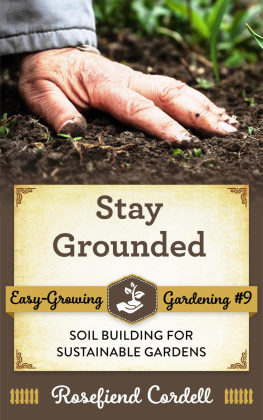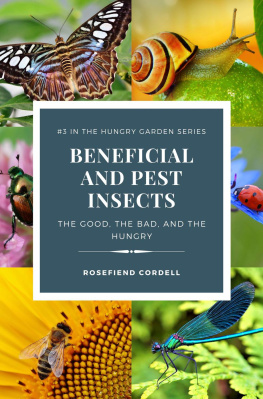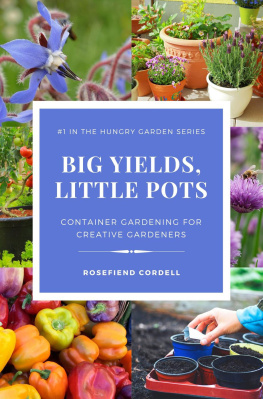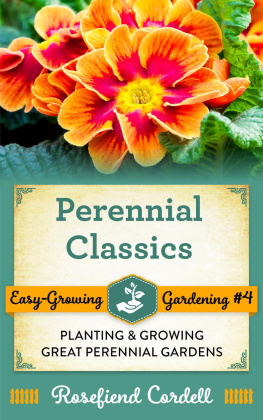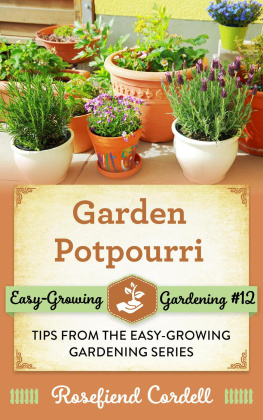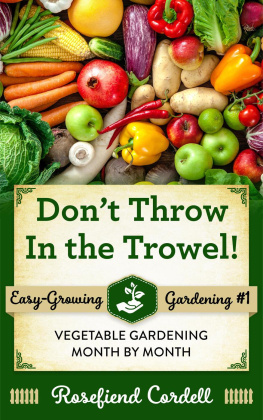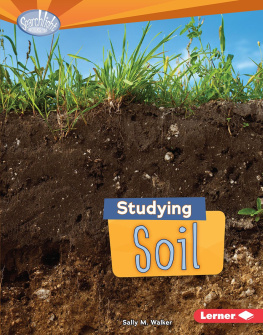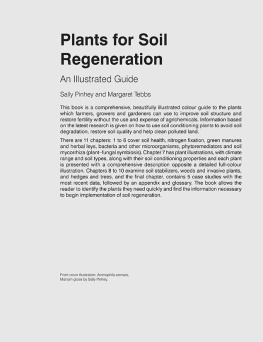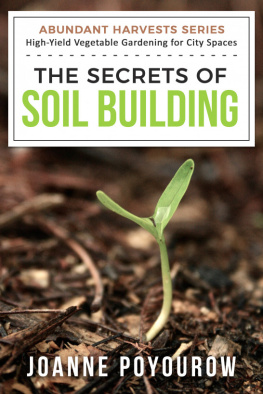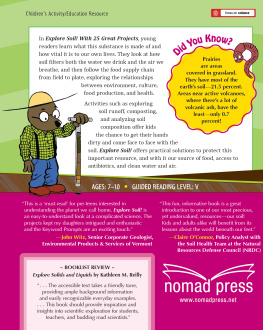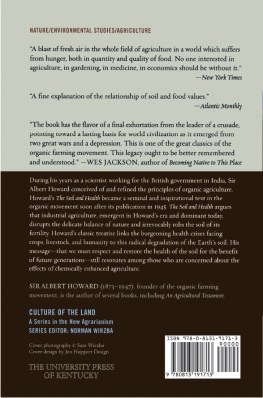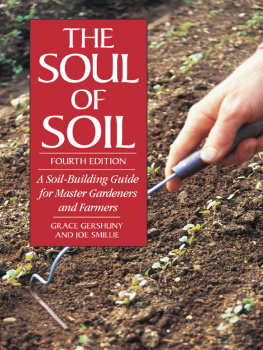Stay Grounded
Also by Rosefiend Cordell
Easy-Growing Gardening
Don't Throw in the Trowel
Rose to the Occasion
If You're a Tomato I'll Ketchup With You
Perennial Classics
Petal to the Metal
Design of the Times
Leave Me a Lawn
Japanese Beetles and Grubs: Trap, Spray, and Control Them
Stay Grounded: Soil Building for Sustainable Gardens
Genius Gardening Hacks: Tips and Fixes for the Creative Gardener
Gardening Month by Month: Tips for Flowers, Vegetables, Lawns, & Houseplants
Garden Potpourri: Gardening Tips from the Easy-Growing Gardening Series
The Hungry Garden
Big Yields, Little Pots: Container Gardening for Creative Gardeners
Edible Landscaping: Foodscaping and Permaculture for Urban Gardeners
Beneficial and Pest Insects: The Good, the Bad, and the Hungry
Watch for more at Rosefiend Cordells site.
Stay Grounded
Soil Building for Sustainable Gardens

Easy-Growing Gardening Guide
Vol. 9
Rosefiend Cordell

Rosefiend Publishing.
S tay Grounded: Soil Building for Sustainable Gardens
Copyright 2017 Melinda R. (Rosefiend) Cordell
Second edition 2020 Melinda R. (Rosefiend) Cordell
All rights reserved. Printed in the United States of America. No part of this book may be used or reproduced in any manner whatsoever without written permission except in the case of brief quotations embodied in critical articles or reviews.
Although the author has made every effort to ensure that the information in this book was correct at press time, the author does not assume and hereby disclaims any liability to any party for any loss, damage, or disruption caused by errors or omissions, whether such errors or omissions result from Murphys Law, the law of averages, the Flying Spaghetti Monster, the fact that your daughter knows how to pronounce existential and you dont, frostbite, chilblains, your being shocked by the temperature dropping to -6 even though this happens every winter , lousy storytelling, not enough heaters in the house, Putinists, Puritans, Pugilists, or other causes.
For more information, contact the publisher at .
ISBN: 978-1-57067-395-5
For more information (and books!), visit www.melindacordell.com
Subscribe to my Newsletter
and get a free gardening book:
https://melindacordell.com/subscribe/

Most of that is good, but anybody who calls me a well-willed little wife is going to get a boot in his butt.

THE SOIL FOOD WEB
To see the world in a grain of sand
And a heaven in a wild flower
S OIL IS FASCINATING . THE SOILS ecosystem is teeming with worms, ants, bacteria (many of which are goodeven the bacteria on your hands), protozoa, springtails, miles and miles of fungi, moles and volesthe list goes on and on. All of these creatures enrich the soil in many different ways.
Worms are a good indicator of how alive your soil is. If you don't see many worms when you dig, your soil may need help. If you see a lot of worms when youre digging, then you have a healthy soil biomass. More about this in the earthworm chapter.
Contrary to popular belif, plants take an active role in ordering their environment. Plants actually have ways to encourage the life of the soil to take up residence around them by secreting many different kinds of compounds into the soil through their roots. These secretions are called root exudates. As early as 1904, scientists noticed that microbes are more abundant in this zone around the roots. Root exudates contain carbohydrates (which include sugar), enzymes, amino acids, and a number of carbon-based compounds, which include valuable proteins.
Soil organisms, attracted by this deliciousness, flock over to load up at this root buffet, and take up residence in a thin zone right up against the roots the rhizosphere so they can chow down.
Bacteria and fungi consume the exudates. Larger microbes, such as nematodes and protozoas, come in and eat the smaller microorganisms. All these creatures excrete wastes, which the plant roots are very happy to absorb as nutrients.
Those protozoa and nematodes, in turn, are eaten by arthropods, which are eaten by other insects, birds, and animals.
Whats more, the plant can control the numbers and types of fungi and bacteria they attract by changing the types of exudates they produce, depending on what the plant needs during that particular season.
But theres more.
Lets slide the scale back to the microscopic and look at soil bacteria, those single-celled organisms. Bacteria are so tiny, that they need to cling to things in order to survive. So, bacteria produce a thin film called a biofilm that sticks to things (and sticks the bacteria to things). If youve ever seen the nasty slime inside a garbage disposal, thats biofilm to the max. In the soil, the biofilm is just thick enough to allow the bacteria to stick to soil particles, and, as an additional side effect, it also causes individual soil particles to stick to other particles. Fungal hyphae, the threads that make up fungus underground, also assists in this microscopic binding of particles. (Fun fact: Fungus actually lives underground. Mushroom are actually their fruiting bodies their version of flowers and fruit. If plants lived this way, all the stems and leaves would be under ground, and their flowers, fruits, and seeds would be above ground.)
The soil clumps that develop, all with the help of bacteria, fungi, and other creatures, are called soil aggregates, and when you have a lot of healthy aggregates, you get great soil structure.
When you compare bare soil to the soil thats around plant roots, youll find a far higher number of microbes an underground community around plant roots.
Earthworms, digging animals, insects, and other small creatures burrow through the soil, creating burrows and gaps that allow air and water to percolate through the soil. Living creatures of all sizes and kinds makes good soil health possible.
Soil Critters Also Add Nutrients
O f course, when a soil -dwelling creature dies, it passes on nutrients to other creatures to be absorbed by fungi, or eaten by bacteria. Bug poop and worm castings are also broken down, releasing more nutrients into the soil for plants to absorb.
Whats more, this organic system holds nutrients in the soil where the roots are, and the nutrients arent washed away, but become a valuable part of the soil. When the plants themselves die, they are also consumed and decayed but the nutrients they release into the soil also stay in place for other creatures and plants to consume. Pretty slick!
On the other hand, chemical fertilizers have no staying power in the root zone. That which isnt absorbed quickly by the roots keeps draining through the soil, carried by the water, until it reaches the water table far below, where it is simply wasted and, technically, adds a little more pollution to the water.
Control Disease Through the Soil Food Web!
N aturally, as in any world, youre going to have your good guys and bad guys and opportunists. For lo, there are plenty of pathogenic bacteria and fungi doing their part to make your plants sick.
Next page
